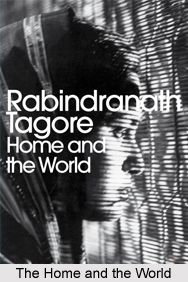 The Home and the World` brings out the then political scenario of India. India`s political situation at the time of 1947 partition was in a state of turmoil and the general public was up in arms against the tyrannical British government. The situation of that era is perfectly depicted in the content of the story The Home and the World`. The author has always taken the contemporary story idea; in his different story the readers can get the feel of the present political situation as well as the cultural changes of the society at that time. The Home and the world is therefore an anecdote of the social, political and above all the emotional turmoil. Rabindranath Tagore like a perfect storyteller has also added some extra flavour while he elevated the theme of boredom and temptation in marriage to a higher plane to encompass all types of emotions and all shades of love.
The Home and the World` brings out the then political scenario of India. India`s political situation at the time of 1947 partition was in a state of turmoil and the general public was up in arms against the tyrannical British government. The situation of that era is perfectly depicted in the content of the story The Home and the World`. The author has always taken the contemporary story idea; in his different story the readers can get the feel of the present political situation as well as the cultural changes of the society at that time. The Home and the world is therefore an anecdote of the social, political and above all the emotional turmoil. Rabindranath Tagore like a perfect storyteller has also added some extra flavour while he elevated the theme of boredom and temptation in marriage to a higher plane to encompass all types of emotions and all shades of love.
Born on 1961 noble laureate Rabindranath Tagore was a man of principle. In 1919, because of the Amritsar massacre of 400 Indian demonstrators by British troops, Sir Tagore renounced his Knighthood. Although a good friend of Mohandas Karamchand Gandhi, most of the time Tagore stayed out of politics. He was opposed to nationalism and militarism as a matter of principle, and instead promoted spiritual values and the creation of a new world culture founded in multi-culturalism, diversity and tolerance as well. He had a saint look. He served as a spiritual and creative beacon to his countrymen, and indeed, the whole world. He used the funds from his writing and lecturing to expand upon the school he had founded. The name of the school is known as Visva Bharati founded in 1901. The alternative to the poor system of education imposed by the British, combined the best of traditional Hindu education with Western ideals. Tagore`s multi-cultural educational efforts were an inspiration to many.
Synopsis:
The story `The Home and the World` is set at the background of the partition time of 1947. This is the time of early 20th century and the story starts at Nikhil`s house who is a noble person. He lives a happy life with his wife Bimala till the time his friend Sandip appeared. From the very first page of the book the love between the two is idealized as something sacred. Nikhil was definitely devoted to his wife and he tried hard to educate her and enable her to discover herself not in the confinements of the four walls of the house but in the big wide world outside. Nikhil`s friend Sandip is a revolutionist. Sandip is a passionate and active man by nature who is a contradiction to the peace-loving and somewhat passive Nikhil. He easily attracts the innocent and unsuspecting Bimala, creating a love triangle as a whole. Although Nikhil figures out what is happening, he doesn`t reveal this his wife. He is mature enough to do that and thus grants Bimala freedom to grow and choose what she wants in her life. They had an arranged marriage and a huge age difference between them. Meanwhile Bimala experiences the emotions of love for the first time in a manner which helps her understand that it is indeed her husband Nikhil who really loves her. The novel ends with Sandeep running away like a common thief after the communal seeds that he had sown in the once peaceful community results in a bloody riot. Bimala loses both her home and the world as Nikhil almost dies trying to quell the riot.













